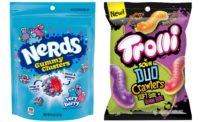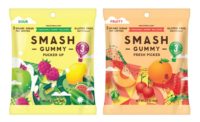Charting a growth course for chewy candy
Innovation in flavor, increased snacking drives chewy candy category upward.

Innovation in fl avor, increased snacking drives chewy category upward.

Innovation in flavor, increased snacking drives chewy category upward.

Innovation in flavor, increased snacking drives chewy category upward.

Innovation in flavor, increased snacking drives chewy category upward.

Innovation in flavor, increased snacking drives chewy category upward.

Innovation in flavor, increased snacking drives chewy category upward.

Innovation in flavor, increased snacking drives chewy category upward.







No matter who’s enjoying it, chewy candy serves as the perfect vehicle for flavor — and fun.
And Morinaga America, maker of HI-CHEW fruit chews, understands that well, as Brand Manager Kayleigh Westerfield points out.
“The appeal of chewy candy lies in the bright, juicy flavors and smooth chewy textures that bring delight to your taste buds,” she said. “Chewy candies are popular with children and continue to attract candy lovers of all ages, as they offer a nostalgic, sweet treat that adds a fun burst of flavor to your day.”
Market data would agree. IRI, a Chicago-based research firm, reported the U.S. non-chocolate chewy candy category reached $3.69 billion in the year ending March 25, up 7.5 percent from the year before. Unit sales surpassed 2.3 billion, up 5 percent over the same period.
Mars Wrigley Confectionery leads the charge with three of the Top 10 brands IRI tracks. Skittles pulled in $333.3 million over the last 52 weeks, representing 9 percent of the market share. Private-label non-chocolate chewy candy took the second spot with sales just missing $275 million. Starburst followed with $259.2 million in sales, occupying a 7 percent market share.
Debbie Litow, brand director at Mars Wrigley Confectionery, attributed the growth to consumers’ desire for new, interesting products — a call manufacturers are answering. She also pointed to the rise in snacking, a trend in which anything goes for busy, on-the-go consumers.
“Gummy candy delivers on this trend with its shareable packaging, easy-to-eat format and lighter flavors,” she said. “As consumers continue to look for ways to snack, the segment will continue to experience growth.”
Keith Domalewski, director of marketing and consumer engagement for Just Born Quality Confections, also cited snacking as driver in the chewy candy sector’s growth, adding increased placement is also key.
“The segment has continued to expand its distribution into nontraditional retail channels such as home improvement, automotive and pet (stores), gaining higher visibility and near-ubiquitous availability,” he said. “Lastly, while smaller in size compared to its traditional retail counterparts, online stores are a new and rapidly growing source of sales for this category.”
Just Born’s Mike and Ikes brand grew by 5.5 percent over the year ending March 25, generating $68.8 million. Domalewski said the Bethlehem, Pa.-based company has seen success with its 10-flavor Mega Mix and its line of sour products, including Zours, Sour-Licious Green Apple and Sour-Licious Fruit Punch.
But that’s not a surprise, since a sour flavor profile and a chewy texture go together like peanut butter and jelly, especially when addressing young people’s palates.
“Teens love sour candy and look for it everywhere they shop, and this has translated into a growth rate nearly double that of the category overall,” Domalewski said.
Further capitalizing on the trend, Just Born will introduce in January a sour Mike and Ike Mega Mix, its sourest candy ever. The company will also launch Hot Tamales Fire & Ice, featuring Fierce Cinnamon and Mint candies in the same package, “allowing consumers to simultaneously heat it up and cool it down with each delicious bite,” Domalewski said.
Combining sweet and spicy flavor profiles has been “hot” across all categories, but chewy textures are an ideal platform for the combination. Litow said feedback on Mars Wrigley’s 2017 introductions of Skittles Sweet Heat and Starburst Sweet Heat has been positive.
“New flavor experiences help drive category growth, and 60 percent of consumers are willing to try spicy candy,” she said, citing Nielsen data. “These products offer spicy options for those looking for a new twist on our popular brands.”
Gaining in popularity is Morinaga America’s HI-CHEW brand, which offers small, rectangular fruit chews packed with flavor. Westerfield noted the company has experienced year-over-year double-digit growth since HI-CHEW launched Stateside a decade ago.
“As the category continues to grow, we’re excited to bring more HI-CHEW flavors and other Morinaga products to our fans in the United States,” Westerfield said.
To celebrate Morinaga’s 10-year anniversary here, the company launched the East Meets West Flavor Challenge, which allowed HI-CHEW fans to vote online for the Japanese flavor they’d like to see in the United States. Voters selected Dragon Fruit, which will appear in the market in 2019.
“We’re excited to see the transition in consumers’ taste buds as they’ve become more receptive to exotic flavors,” Westerfield said. “HI-CHEW is known to have more than 170 flavors worldwide, but only a handful of those are currently available in the United States. As consumers are exploring their chewy candy selections more frequently, we hope to bring new and exciting products to feed that craving.”
Morinaga America has also launched an Açai flavor, a nod to the increasing popularity of the superfruit — Açai is known for its high antioxidant and fiber content — as well as HI-CHEW Plus Fruit, which incorporates real fruit into each piece. Those are available in Mango & Pineapple and Cranberry & Grape flavors.
Furthermore, Morinaga has retooled its Tropical Flavor Mix to include Pineapple, Kiwi and Mango.
“Looking ahead, we are continuing to listen to HI-CHEW fans’ feedback and have plans to release more interesting flavors that reflect the taste preferences of American candy lovers,” Westerfield said.
The more fun they are, the better.
Looking for a reprint of this article?
From high-res PDFs to custom plaques, order your copy today!












